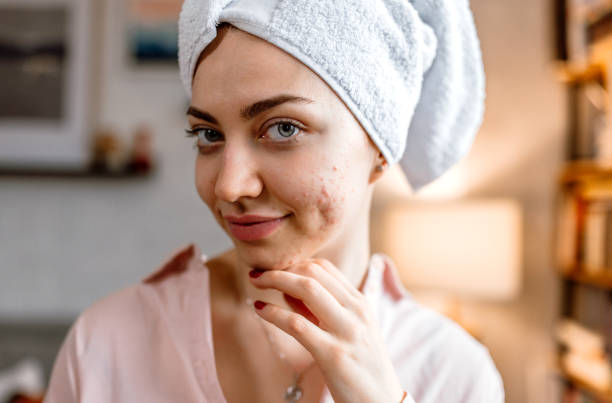Cystic acne is one of the most severe forms of acne, characterized by deep, inflamed, and painful cysts that can lead to significant skin damage and scarring. Unlike more common forms of acne that involve blackheads, whiteheads, and pimples, cystic acne forms deep under the skin and can be stubbornly resistant to conventional treatments. This article delves into the latest insights on the symptoms and causes of cystic acne, shedding light on this often misunderstood condition. buy accutane online best solution for acne.
Symptoms of Cystic Acne
Cystic acne manifests through a range of symptoms that distinguish it from milder forms of acne. Key symptoms include:
- Deep, Inflamed Lesions: Cystic acne presents as large, red, and painful bumps beneath the skin. These lesions are filled with pus and can be tender to the touch.
- Nodules: Hard, painful lumps known as nodules form under the skin. These nodules can persist for weeks or even months and are often resistant to typical over-the-counter acne treatments with Accutane generic.
- Cysts: Unlike nodules, cysts are softer and filled with pus. They can become quite large and are often more inflamed and painful.
- Scarring: Due to the deep nature of the inflammation, cystic acne is more likely to lead to permanent scarring. Scars can be pitted (atrophic), raised (hypertrophic), or keloid in nature.
- Wide Distribution: While common acne is often localized to the face, cystic acne can affect larger areas of the skin, including the chest, back, shoulders, and upper arms.
Causes of Cystic Acne
Understanding the causes of cystic acne is crucial for effective treatment and prevention. The condition results from a combination of genetic, hormonal, and environmental factors.
1. Hormonal Fluctuations
Hormones play a significant role in the development of cystic acne. Androgens, particularly testosterone, can increase the size and activity of sebaceous (oil) glands, leading to excessive oil production. This overproduction of sebum can clog pores, creating an environment where bacteria can thrive and cause inflammation. Hormonal fluctuations are particularly common during puberty, menstrual cycles, pregnancy, and in conditions such as polycystic ovary syndrome (PCOS).
2. Genetics
A family history of severe acne can predispose individuals to cystic acne. Genetic factors can influence how the skin responds to hormones, how much oil the sebaceous glands produce, and how prone an individual is to inflammation and scarring.
3. Bacterial Infection
The bacterium Cutibacterium acnes (formerly Propionibacterium acnes) is commonly found on the skin and can contribute to acne formation. In the case of cystic acne, the bacteria get trapped in clogged pores, leading to infection and severe inflammation. The immune system’s response to this infection can further exacerbate the severity of acne.
4. Diet
Emerging research suggests a link between diet and acne. High glycemic index foods, which cause rapid spikes in blood sugar levels, can exacerbate acne. Dairy products, particularly skim milk, have also been implicated in worsening acne symptoms. These foods can influence hormone levels and inflammation, potentially triggering or worsening cystic acne.
5. Stress
Stress is known to affect hormone levels, particularly cortisol, which can in turn influence oil production and inflammation in the skin. Chronic stress can exacerbate acne by disrupting hormonal balance and the skin’s natural healing processes.
6. Skincare and Cosmetic Products
Using heavy, oil-based skincare or cosmetic products can clog pores and contribute to the development of cystic acne. It’s essential to use non-comedogenic (non-pore-clogging) products, especially for individuals prone to acne.
Latest Insights and Research
Recent studies and advancements in dermatology have provided deeper insights into the mechanisms and management of cystic acne.
Inflammation and Immune Response
Research has highlighted the role of inflammation and the immune response in the development of cystic acne. It’s not merely the presence of bacteria or clogged pores, but how the body responds to these issues that determines the severity of acne. Targeting inflammatory pathways and modulating the immune response are emerging areas of acne treatment.
Microbiome Balance
The skin’s microbiome, which includes a variety of bacteria and other microorganisms, plays a crucial role in skin health. Disruptions to this balance can lead to acne. Probiotics and prebiotics are being explored as potential treatments to restore a healthy skin microbiome and reduce acne severity.
Hormonal Treatments
For individuals with hormonally driven cystic acne, treatments that target hormonal balance are proving effective. Oral contraceptives, anti-androgens like spironolactone, and hormone-regulating medications can significantly reduce acne in these cases. Personalized treatment plans based on hormonal profiles are becoming more common.
Novel Topical Treatments
New topical treatments are being developed that offer more targeted action with fewer side effects. These include retinoids, which promote cell turnover and prevent clogged pores, and benzoyl peroxide, which reduces bacteria and inflammation. Innovations in delivery systems, such as microencapsulation, are enhancing the effectiveness and tolerability of these treatments.
Lifestyle and Holistic Approaches
A holistic approach to managing cystic acne includes addressing lifestyle factors such as diet, stress management, and skincare routines. Incorporating a balanced diet, reducing stress through mindfulness or therapy, and using gentle, non-comedogenic skincare products can complement medical treatments.
Conclusion
Cystic acne is a complex and multifactorial condition that requires a comprehensive understanding of its symptoms and causes for effective management. Advances in research have provided new insights into the roles of hormones, genetics, bacteria, and lifestyle factors in the development of cystic acne. By addressing these underlying causes and utilizing a combination of medical and holistic treatments, individuals can achieve better control over their skin health and reduce the impact of cystic acne on their lives.

